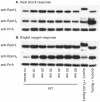Convergence of the transcriptional responses to heat shock and singlet oxygen stresses
- PMID: 23028346
- PMCID: PMC3441632
- DOI: 10.1371/journal.pgen.1002929
Convergence of the transcriptional responses to heat shock and singlet oxygen stresses
Abstract
Cells often mount transcriptional responses and activate specific sets of genes in response to stress-inducing signals such as heat or reactive oxygen species. Transcription factors in the RpoH family of bacterial alternative σ factors usually control gene expression during a heat shock response. Interestingly, several α-proteobacteria possess two or more paralogs of RpoH, suggesting some functional distinction. We investigated the target promoters of Rhodobacter sphaeroides RpoH(I) and RpoH(II) using genome-scale data derived from gene expression profiling and the direct interactions of each protein with DNA in vivo. We found that the RpoH(I) and RpoH(II) regulons have both distinct and overlapping gene sets. We predicted DNA sequence elements that dictate promoter recognition specificity by each RpoH paralog. We found that several bases in the highly conserved TTG in the -35 element are important for activity with both RpoH homologs; that the T-9 position, which is over-represented in the RpoH(I) promoter sequence logo, is critical for RpoH(I)-dependent transcription; and that several bases in the predicted -10 element were important for activity with either RpoH(II) or both RpoH homologs. Genes that are transcribed by both RpoH(I) and RpoH(II) are predicted to encode for functions involved in general cell maintenance. The functions specific to the RpoH(I) regulon are associated with a classic heat shock response, while those specific to RpoH(II) are associated with the response to the reactive oxygen species, singlet oxygen. We propose that a gene duplication event followed by changes in promoter recognition by RpoH(I) and RpoH(II) allowed convergence of the transcriptional responses to heat and singlet oxygen stress in R. sphaeroides and possibly other bacteria.
Conflict of interest statement
The authors have declared that no competing interests exist.
Figures





Similar articles
-
Overlapping alternative sigma factor regulons in the response to singlet oxygen in Rhodobacter sphaeroides.J Bacteriol. 2010 May;192(10):2613-23. doi: 10.1128/JB.01605-09. Epub 2010 Mar 19. J Bacteriol. 2010. PMID: 20304993 Free PMC article.
-
RpoH(II) activates oxidative-stress defense systems and is controlled by RpoE in the singlet oxygen-dependent response in Rhodobacter sphaeroides.J Bacteriol. 2009 Jan;191(1):220-30. doi: 10.1128/JB.00925-08. Epub 2008 Oct 31. J Bacteriol. 2009. PMID: 18978062 Free PMC article.
-
Activity of Rhodobacter sphaeroides RpoHII, a second member of the heat shock sigma factor family.J Bacteriol. 2006 Aug;188(16):5712-21. doi: 10.1128/JB.00405-06. J Bacteriol. 2006. PMID: 16885439 Free PMC article.
-
Singlet oxygen stress in microorganisms.Adv Microb Physiol. 2011;58:141-73. doi: 10.1016/B978-0-12-381043-4.00004-0. Adv Microb Physiol. 2011. PMID: 21722793 Review.
-
Transcriptional regulation of stress-inducible genes in procaryotes.EXS. 1996;77:165-81. doi: 10.1007/978-3-0348-9088-5_11. EXS. 1996. PMID: 8856974 Review.
Cited by
-
The essential Rhodobacter sphaeroides CenKR two-component system regulates cell division and envelope biosynthesis.PLoS Genet. 2022 Jun 29;18(6):e1010270. doi: 10.1371/journal.pgen.1010270. eCollection 2022 Jun. PLoS Genet. 2022. PMID: 35767559 Free PMC article.
-
Ribonuclease E strongly impacts bacterial adaptation to different growth conditions.RNA Biol. 2023 Jan;20(1):120-135. doi: 10.1080/15476286.2023.2195733. RNA Biol. 2023. PMID: 36988476 Free PMC article.
-
Proteins needed to activate a transcriptional response to the reactive oxygen species singlet oxygen.mBio. 2013 Jan 8;4(1):e00541-12. doi: 10.1128/mBio.00541-12. mBio. 2013. PMID: 23300250 Free PMC article.
-
The Impact of the Major Endoribonucleases RNase E and RNase III and of the sRNA StsR on Photosynthesis Gene Expression in Rhodobacter sphaeroides Is Growth-Phase-Dependent.Int J Mol Sci. 2024 Aug 22;25(16):9123. doi: 10.3390/ijms25169123. Int J Mol Sci. 2024. PMID: 39201809 Free PMC article.
-
Global analysis of photosynthesis transcriptional regulatory networks.PLoS Genet. 2014 Dec 11;10(12):e1004837. doi: 10.1371/journal.pgen.1004837. eCollection 2014 Dec. PLoS Genet. 2014. PMID: 25503406 Free PMC article.
References
-
- Staron A, Sofia HJ, Dietrich S, Ulrich LE, Liesegang H, et al. (2009) The third pillar of bacterial signal transduction: classification of the extracytoplasmic function (ECF) sigma factor protein family. Mol Microbiol - PubMed
Publication types
MeSH terms
Substances
Associated data
- Actions
Grants and funding
LinkOut - more resources
Full Text Sources
Molecular Biology Databases

